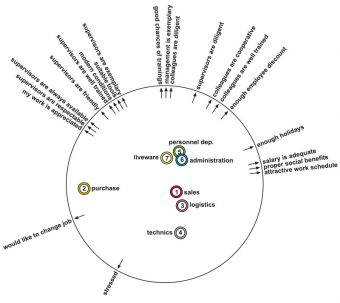Multidimensional Scaling
Objective of Multidimensional scaling (MDS)
With multidimensional scaling (MDS), complex interrelationships between objects can be portrayed visually in an easily viewable and interpretable fashion. These objects can be products or services as well as buyer segments or specific target groups.
If the objects are products that are rated as similar by the participants in item batteries, these products will be closer to one another in the graphical depiction. Products which are rated as different will correspondingly be positioned farther apart from one another. In this way, for instance, it is possible for a company to immediately gauge the position of its own product in the competitive landscape, thus making it easier to recognize the situation and the appropriate strategic connections.
If, however, the objects in question are persons, such as customers being surveyed about a service as part of a customer satisfaction study, groups of persons who may have e.g. rated various statements in a similar way will be closer together in the graphical depiction. Groups of persons who have rated these statements differently will be correspondingly positioned further apart from one another. In this manner, it becomes easier to differentiate the attitudes and expectations of various target groups and to categorize customer groups. A practical example can be found here.
Prerequisites
As a rule, multidimensional scaling can always be carried out when statement batteries are used. Metric variables or percentages can be used as data. The sample size required depends on the homogeneity of opinions represented by the respondents. The more homogenous the range of opinions, the smaller the sample can be.
Because the clarity of the MDS depiction is achieved by reducing the entire attribute space to only two dimensions, an exact reproduction of all attributes is not guaranteed. Attributes which lose more than a third of their information should be removed from the analysis or at least appropriately labeled.



